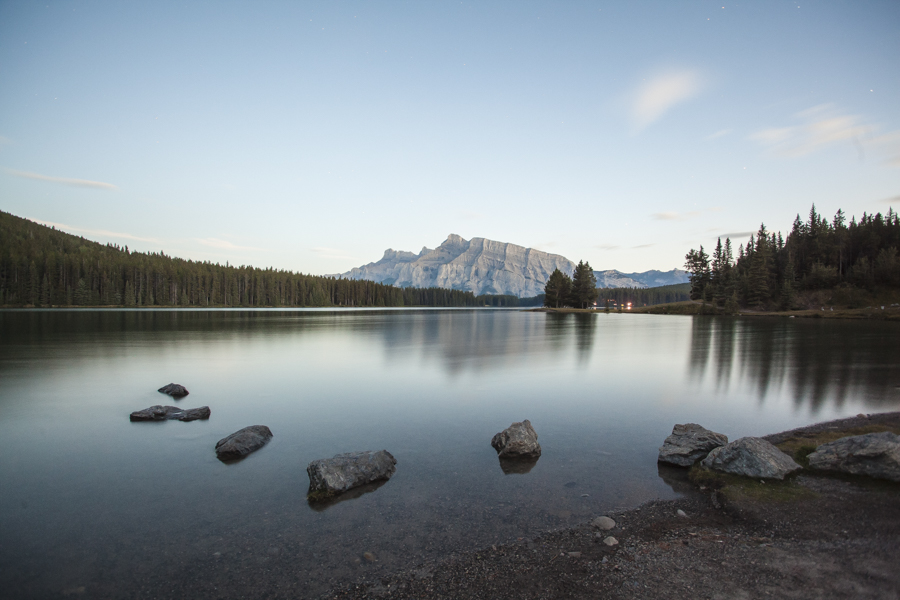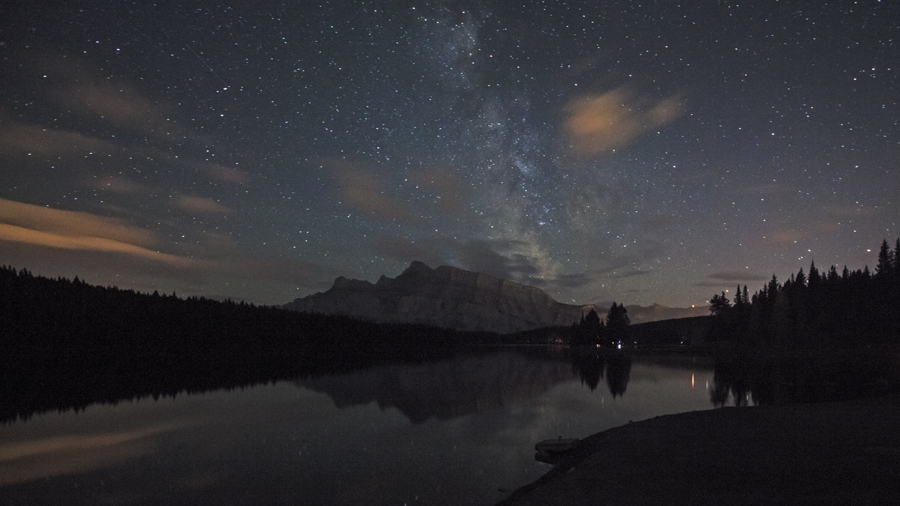Earlier this week, I went out with members of the Canmore Camera Club for a night time shoot. Our purpose was to capture pictures of the Milky Way, the galaxy that contains our Solar System. Its name “milky” is derived from its appearance as a dim glowing band arching across the night sky whose individual stars cannot be distinguished by the naked eye. The time was chosen carefully, at a time of the year when the galaxy is still very visible in the northern hemisphere and a time of the month when the moon’s brightness isn’t overpowering. The location, Two Jack Lake in Banff National Park was also carefully chosen, not too far away but far enough from the Town of Banff as not to “pollute” the sky with its light. We positioned ourselves to capture the Milky Way as it emerged from behind Mount Rundle, beyond the far end of the lake. We anticipated a clear sky, but we experienced mixed clouds, although not enough to obscure our objective. In my view, the few clouds that were present reflected some light from Banff, adding colour to the scene.
We began at about 10:00 PM, an hour after sunset. My first picture, taken at 9:55 is a little misleading, in that it was darker than it appears in the picture. I was using a long exposure in preparation for the darkness that was soon to come. I used a wide angle lens (17-40 mm) at a focal length of 17 mm, with an ISO setting of 800 and a shutter speed of 30 sec. I was set up to gather light and I succeeded! You can tell it was a long exposure by the highly polished surface of the lake.

The strategy for photographing stars is to gather as much light as you can within a limited time period. That time period is constrained by the movement of the stars relative to earth. By leaving the shutter open too long, that movement becomes evident as the stars leave trails, as opposed to appearing as single points of light. The allowed time gets longer with the focal length you are using. The wider the angle, the larger the amount of sky included in the frame and the less apparent the movement of the stars. The rule of the thumb that governs the photography of the stars is the “500 Rule”, which states that the shutter speed (or time the shutter remains open) should not exceed 500 divided by the focal length being used. In the picture that follows, I used a shutter speed of 30 sec, slightly longer than the prescribed amount for the focal length of 21 mm I used for the picture. (500/21~24 seconds). I’ve also heard reference to the “600 Rule” which implies you can get away with a little longer shutter speed!
So, the technique is to use a tripod to hold the camera perfectly still and open the aperture as wide as you can to gather as much light as possible in the time available. The third important variable is the ISO setting. A high setting is required because it is very dark and increasing the sensor sensitivity is essential to capturing enough light in the time available, in this case 30 seconds. I used an ISO setting of 3200 to get the following photograph, high enough to get the light required without unduly introducing “noise” (in the form of coloured speckles) into the image. I’ve chosen to emphasize the sky and its reflection in the lake. I’ve left the lake’s shoreline very dark and Mount Rundle a little lighter. I have the noise pretty much under control. (Those specks in the sky are stars , not noise!) The clouds were a mixed blessing. The pink/orange coloured ones are a nice complement but there is one cloud just above the mountain, obscuring the lower and most vivid part of the Milky Way. Drat!
I should mention that the image may appear darker on your screen than it does on mine. I prepare the image to best represent what I saw which may not appear the same on your screen. Luminance and colour vary with the screens on different monitors, tablets and phones. If you are able to increase/decrease the luminance of the screen you’re using, try it.

It was great evening, although a long one. It’s nice to be out in the park at night and I did considerable experimenting, a great way to learn.

Lovely! Worth the effort.
Lovely Peter! I will have to try something like tis soon.